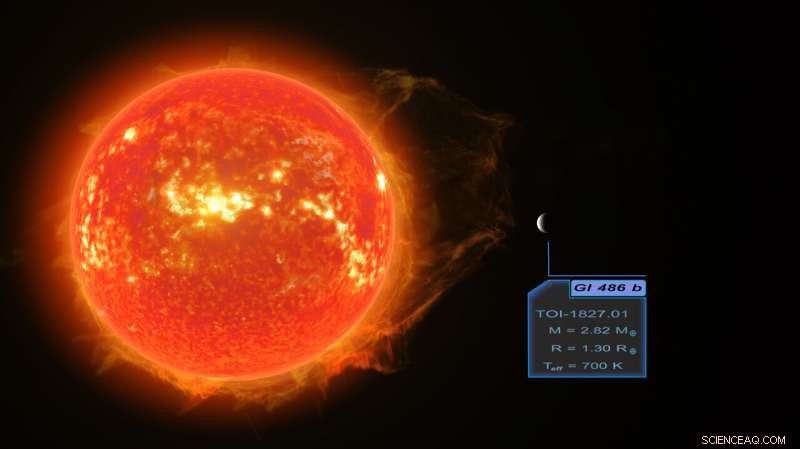
Momentos del viaje virtual, con datos astronómicos superpuestos. Crédito:RenderArea
Durante los últimos 25 años, los astrónomos han descubierto una amplia variedad de exoplanetas, hecho de roca, hielo y gas, gracias a la construcción de instrumentos astronómicos diseñados específicamente para búsquedas de planetas. También, utilizando una combinación de diferentes técnicas de observación han podido determinar un gran número de masas, tamaños y por tanto densidades de los planetas, lo que les ayuda a estimar su composición interna y aumenta el número de planetas que se han descubierto fuera del Sistema Solar.
Sin embargo, estudiar las atmósferas de los planetas rocosos, lo que permitiría caracterizar completamente aquellos exoplanetas que son similares a la Tierra, es extremadamente difícil con los instrumentos disponibles actualmente. Por esta razón, los modelos atmosféricos para planetas rocosos siguen sin ser probados.
Así que es interesante que los astrónomos de los CARMENES (Calar Alto busquen enanas M de alta resolución con Exoearths con espectrógrafos échelle ópticos y de infrarrojo cercano), consorcio en el que el Instituto de Astrofísica de Canarias (IAC) es socio, han publicado recientemente un estudio, dirigido por Trifon Trifonov, astrónomo del Instituto Max Planck de Astronomía en Heidelberg (Alemania), sobre el descubrimiento de una super-Tierra caliente en órbita alrededor de una estrella enana roja cercana Gliese 486, a solo 26 años luz del sol.
Para ello, los científicos utilizaron las técnicas combinadas de fotometría de tránsito y espectroscopia de velocidad radial, y usado, entre otros, observaciones con el instrumento MuSCAT2 (Cámara Multicolor Simultánea para el Estudio de Atmósferas de Exoplanetas en Tránsito) en el Telescopio Carlos Sánchez de 1,52m del Observatorio del Teide. Los resultados de este estudio se han publicado en la revista Ciencias .
El planeta que descubrieron llamado Gliese 486b, tiene una masa 2,8 veces mayor que la de la Tierra, y es solo un 30% más grande. "Calculando su densidad media a partir de las medidas de su masa y radio, inferimos que su composición es similar a la de Venus o la Tierra, que tienen núcleos metálicos en su interior, "explica Enric Pallé, investigador del IAC y coautor del artículo.
Gliese 486b orbita su estrella anfitriona en una trayectoria circular cada 1,5 días, a una distancia de 2,5 millones de kilómetros. A pesar de estar tan cerca de su estrella, el planeta probablemente ha conservado parte de su atmósfera original (la estrella es mucho más fría que nuestro Sol) por lo que es un buen candidato para observar con más detalle con la próxima generación de telescopios espaciales y terrestres.
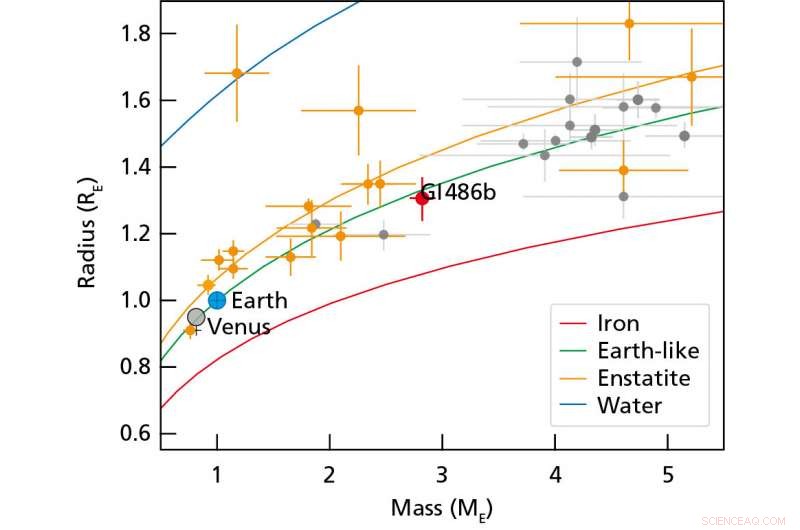
El diagrama proporciona una estimación de las composiciones interiores de exoplanetas seleccionados en función de sus masas y radios en unidades terrestres. El punto rojo representa Gliese 486b, y los símbolos naranjas representan planetas alrededor de estrellas frías como Gliese 486. Los puntos grises muestran planetas alojados por estrellas más calientes. Las curvas de color indican las relaciones de radio de masa teóricas para agua pura a 700 K (azul), para el mineral enstatita (naranja), para la Tierra (verde), y hierro puro (rojo). En comparación, el diagrama también destaca Venus y la Tierra. Crédito:Trifonov et al./ Departamento de Gráficos de MPIA.
Para Trifonov, "El hecho de que este planeta esté tan cerca del Sol es emocionante porque será posible estudiarlo con más detalle utilizando potentes telescopios como el iminente Telescopio Espacial James Webb y el ELT (Telescopio Extremadamente Grande) que se está construyendo".
Gliese 486b tarda el mismo tiempo en girar sobre su eje que en orbitar su estrella anfitriona, para que siempre tenga el mismo lado de cara a la estrella. Aunque Gliese 486 es mucho más débil y frío que el Sol, la radiación es tan intensa que la superficie del planeta se calienta hasta al menos 700 K (unos 430 grados C). Debido a esto, la superficie de Gliese 486b es probablemente más parecida a la superficie de Venus que a la de la Tierra, con un paisaje seco y caluroso, with burning rivers of lava. Sin embargo, unlike Venus, Gliese 486b may have a thin atmosphere.
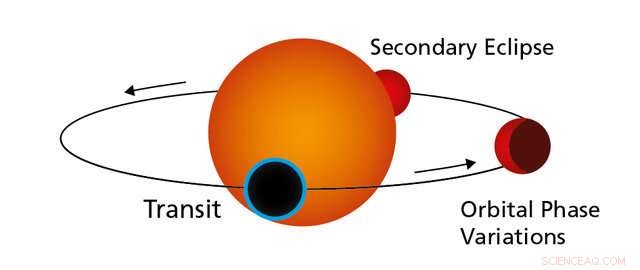
The graph illustrates the orbit of a transiting rocky exoplanet like Gliese 486b around its host star. During the transit, the planet eclipses the stellar disk. Simultaneamente, a small portion of the starlight passes through the planet's atmosphere. As Gliese 486b continues to orbit, parts of the illuminated hemisphere become visible as phases until the planet disappears behind the star. Credit:MPIA Graphics Department.
Calculations made with existing models of planetary atmospheres can be consistent with both hot surface and thin atmosphere scenarios because stellar irradiation tends to evaporate the atmosphere, while the planet's gravity tends to hold it back. Determining the balance between the two contributions is difficult today.
"The discovery of Gliese 486b has been a stroke of luck. If it had been around a hundred degrees hotter all its surface would be lava, and its atmosphere would be vaporized rock, " explains José Antonio Caballero, a researcher at the Astrobiology Centre (CAB, CSIC-INTA) and co-author of the article. "Por otra parte, if Gliese 486b had been around a hundred degrees cooler, it would not have been suitable for the follow-up observations."
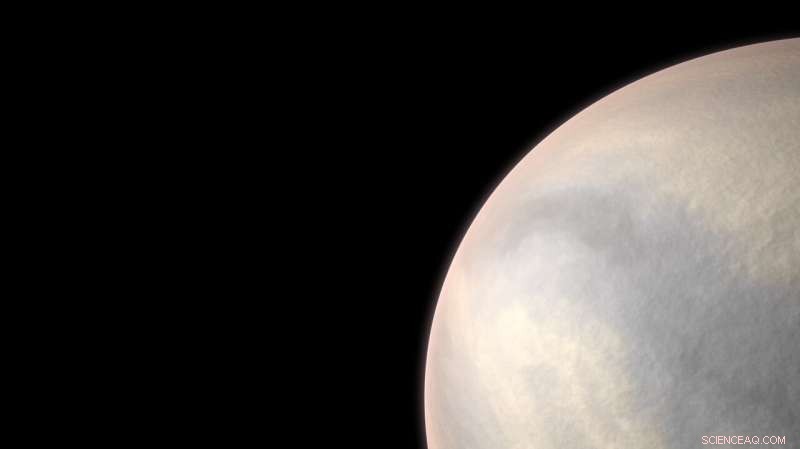
Artist's impression of the atmosphere of Gliese 486b. Credit:RenderArea
Future planned observations by the CARMENES team will try to determine its orbital inclination, which makes it possible for Gliese 486b to cross the line of sight between us and the surface of the star, oculting some of its light, and producing what are known as transits.
They will also make spectroscopic measurements, using emission spectroscopy, when the areas of the hemisphere lit up by the star are visible as phases of the planet (analagous to the phases of our Moon), during the orbits of Gliese 486b, before it disappears behind the star. The spectrum observed will contain information about the conditions on the illuminated hot surface of the planet.
"We can't wait until the new telescopes are available, " admits Trifonov. "The results we may obtain with them will help us to get a better understanding of the atmospheres of rocky planets, their extensión, their very high density, their composition, and their influence in distributing energy around the planets.
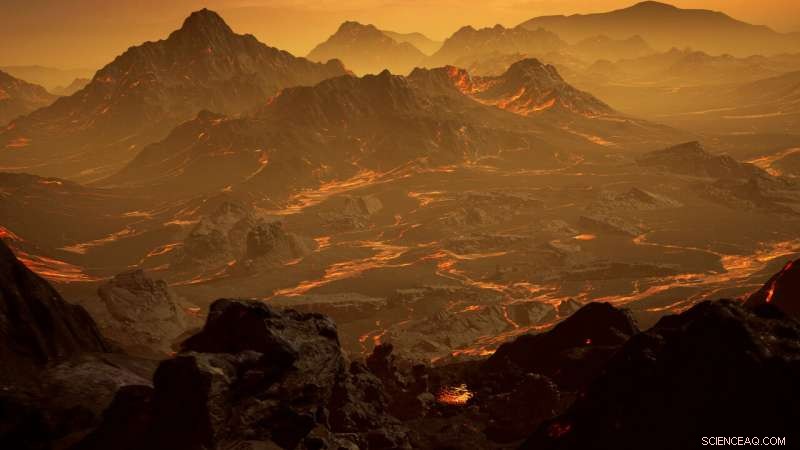
Artistic impression of the surface of the newly discovered hot super-Earth Gliese 486b. With a temperature of about 700 Kelvin (430 °C), Gliese 486b possibly has an atmosphere. Credit:RenderArea
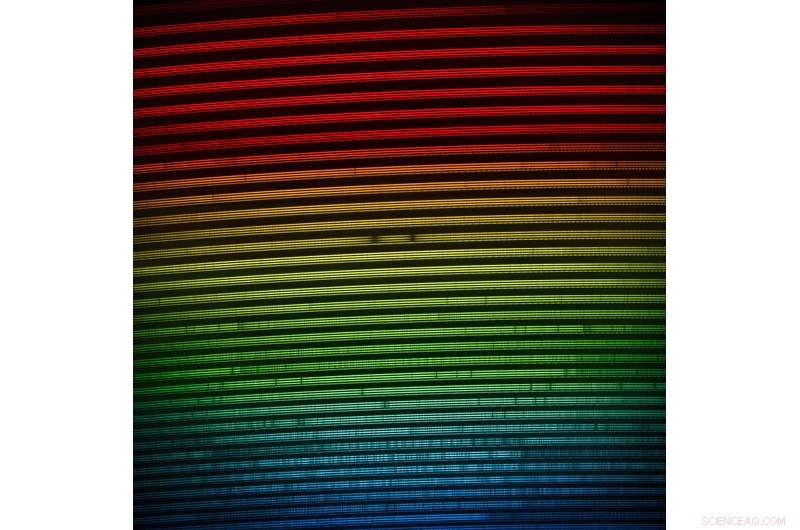
Colorized 2D spectra of the star Gliese 486 as seen with MAROON-X. The two spectra are from the two camera arms of MAROON-X. Each spectrum covers the 500-670 nm wavelength range and the color-coding corresponds to how a human eye would perceive the colors. Credit:International Gemini Observatory/NOIRLab/NSF/AURA/A. Seifahrt
The CARMENES project, whose consortium is made up by 11 research institutions in Spain and Germany, has the aim of monitoring a set of 350 red dwarf stars to seek planets like the Earth, using a spectrograph on the 3.5 m telescope at the Calar Alto Observatory (Spain). The present study has also used spectroscopic measurements to infer the mass of Gliese 486b. Observations were made with the MAROON-X instrument on Gemini North (8.1m) in the USA, and archive data were taken from the Keck 10 m telescope (USA) and the 3.6m telescope of ESO, (Chile).
The photometric observations come from NASA's TESS (Transiting Exoplanet Survey Satellite) space observatory, (USA), whose data were basic for obtaining the radius of the planet, from the MuSCAT2 instrument on the 1.52m Carlos Sánchez Telescope at the Teide Observatory (Spain) and from the LCOGT (Las Cumbres Observational Global Telescope) in Chile, entre otros.